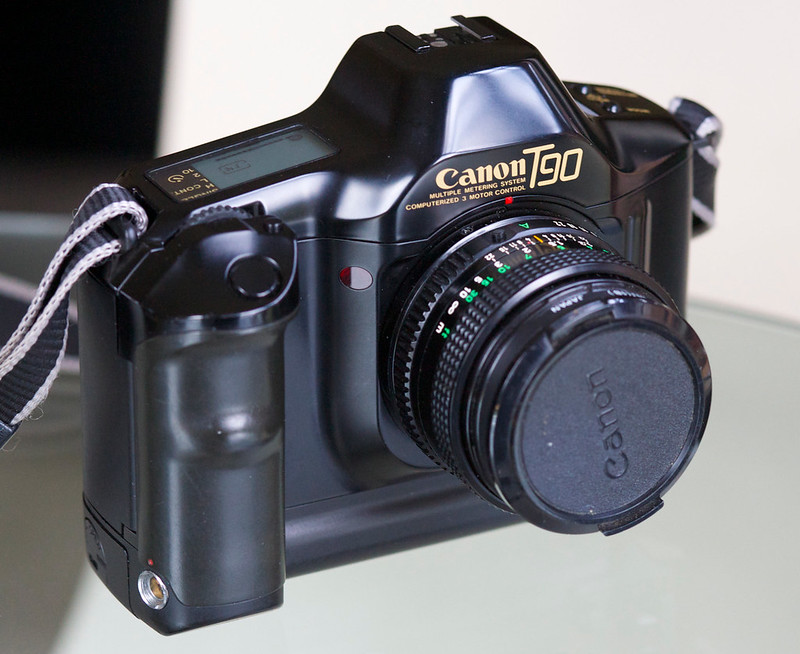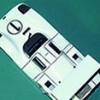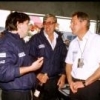

Things in common
#1

Posted 02 December 2012 - 18:38

Advertisement
#2

Posted 02 December 2012 - 18:51
The curvy shape of the design and the fact that you have to look through the front element to operate it, probably help give it away!
#3

Posted 02 December 2012 - 19:01
#4

Posted 02 December 2012 - 19:13
The car is currently owned by a TNFer, I believe.
Really? Bet it doesn't utilise the original bodywork!
#5

Posted 02 December 2012 - 19:15
The curvy shape of the design and the fact that you have to look through the front element to operate it, probably help give it away!
I think you can see around the mirror OK, if that's what you mean...
#6

Posted 02 December 2012 - 19:41
#7

Posted 02 December 2012 - 19:49
DCN
#8

Posted 02 December 2012 - 19:50
Would they both be suitable for a fresh-air holiday in Germany? The Black Forest perhaps, or maybe the countryside around the Nurburgring?
Very good
#9

Posted 02 December 2012 - 19:53
#10

Posted 02 December 2012 - 19:55
The Canon T90 body was designed by Luigi Colani, also the perpetrator of the Eifelland March 721.
Nicely worded Dolomite - I like the implied criminality of the Eifelland design
#12

Posted 02 December 2012 - 20:59
What does it have in common with a '60s Indy winner?
DCN
Ah, Doug, wasn't that a T92?
#13

Posted 02 December 2012 - 21:35
Graham Hill won the 1966 Indy 500 in a Lola T90.Ah, Doug, wasn't that a T92?
Edited by gkennedy, 03 December 2012 - 11:43.
#14

Posted 02 December 2012 - 21:39
Nicely worded Dolomite - I like the implied criminality of the Eifelland design
I'm glad Luigi stuck his neck out even though his idea's did not work.
It's not like the 721 was setting the world on fire if you compare Pescarolo's progress, best 8th place finish in the 'standard customer' Williams 721, with Rolf's two best 10th place finishes in the Eifelland example, or with the works 712X which achieved a best 9th place finish one might conclude that it was worth Eifelland taking a risk even if it did not pay off
#15

Posted 03 December 2012 - 07:48
I'm glad Luigi stuck his neck out even though his idea's did not work.
It's not like the 721 was setting the world on fire if you compare Pescarolo's progress, best 8th place finish in the 'standard customer' Williams 721, with Rolf's two best 10th place finishes in the Eifelland example, or with the works 712X which achieved a best 9th place finish one might conclude that it was worth Eifelland taking a risk even if it did not pay off
Fair point Arti, mine was just a cheap shot! The look of the Eifelland car never really caught my imagination, whereas I rather liked the 711, the 721 and the 721G, if not the technically interesting 721X.
#16

Posted 03 December 2012 - 09:09
Fair point Arti, mine was just a cheap shot! The look of the Eifelland car never really caught my imagination, whereas I rather liked the 711, the 721 and the 721G, if not the technically interesting 721X.
I was not in the Formula One loop when I saw a press release photo of the Eifelland in the workshop in 1972, it's futuristic look caught my imagination in the same way as the Ensign MN173 the following year
Edited by arttidesco, 03 December 2012 - 09:10.
#17

Posted 03 December 2012 - 11:27
#18

Posted 03 December 2012 - 13:20
Can't comment on Sig. Colani's work on the March but I think he did a good job on the camera. Mine gets exercised once or twice a year and is still quite intuitive to use. The most technically advanced manual focus film camera ever produced, at least for the non-pro market?
I think the style and controls of all subsequent Canon SLR cameras owe something to the T90. Perhaps this applies to other makes too...
Edited by David Beard, 03 December 2012 - 13:21.
#19

Posted 03 December 2012 - 14:11
Can't comment on Sig. Colani's work on the March but I think he did a good job on the camera. Mine gets exercised once or twice a year and is still quite intuitive to use. The most technically advanced manual focus film camera ever produced, at least for the non-pro market?
No contest.


Advertisement
#20

Posted 03 December 2012 - 14:27
Am I right in thinking that Owen Maclaren of Maclaren Pushchair fame also designed the under carriage of the DeHavilland Mosquito?
#21

Posted 03 December 2012 - 14:34
Interesting topic. I suppose Designers turn their hand to all sorts of things.
Am I right in thinking that Owen Maclaren of Maclaren Pushchair fame also designed the under carriage of the DeHavilland Mosquito?
And of course Ron Hickman...Workmate and elements of Lotus...
Edited by David Beard, 03 December 2012 - 14:36.
#22

Posted 03 December 2012 - 14:43
The Canon T90 body was designed by Luigi Colani....
Colani had input on the styling of the Canon T90's body.
Would be nice if some of the stylists, designers and engineers at Canon got their share of the credit.
#23

Posted 03 December 2012 - 15:02
Am I right in thinking that Owen Maclaren of Maclaren Pushchair fame also designed the under carriage of the DeHavilland Mosquito?
Not sure, but Owen certainly did design the undercarriage for the Spitfire.
#24

Posted 03 December 2012 - 20:20
#25

Posted 03 December 2012 - 20:36
The Norris brothers, famous for designing Donald Campbell's Bluebird cars and boat, and having some aerodynamic input on the Hill Lola(or maybe GH1) also designed hundreds and hundreds of non-motorsport items including the inertia-reel seatbelt, concrete pumps, micro switches and a rotary engine for motorcycle use.
And what about the late and great Anthony Colin Bruce Chapman? As well as all the car-related stuff we all know about, he was also responsible for a number of boats, ranging from small racing hulls to be raced by son Clive, to luxury cruisers up to 46' long. There were also microlight aircraft, an inflatable reclining chair, and in collaboration with the similarly gifted Ron Hickman, some prototype designs for fibreglass seating units.
#26

Posted 04 December 2012 - 06:46
(If you Google for him, he's not to be confused with the more traditional furniture maker of the same name.)
(Barnard became a 'Royal Designer for Industry' sometime in the mid-nineties.)
Edited by 2F-001, 04 December 2012 - 06:56.
#27

Posted 04 December 2012 - 19:43
Graham Hill won the 1966 Indy 500 in a Lola T90.
Serves me well for not checking facts before I post! I just remembered that there was another Lola at Indy in '65, and failed to recall its type designation was T80...
#29

Posted 04 December 2012 - 22:03
Edited by Nigel Beresford, 04 December 2012 - 22:08.
#30

Posted 04 December 2012 - 22:18
#31

Posted 04 December 2012 - 22:28
For what it's worth, I think mentioning Chapman and Barnard has value because it serves to illustrate that the most fantastic (and superior) aesthetics can happily result from proper application of the design process, rather than sitting down consciously trying to "create" beauty with no regard for other considerations.
Thanks
Nigel
Edited by Nigel Beresford, 04 December 2012 - 22:39.
#32

Posted 04 December 2012 - 22:45
#33

Posted 04 December 2012 - 22:51
#34

Posted 04 December 2012 - 22:52
#35

Posted 04 December 2012 - 23:26
As a design engineer, I frequently have to consciously remind myself the "designer" and "engineer" are not synonyms eitherThanks - very good points, very well presented. I guess I'm too sensitive because of my dislike for the careless synonym-like use of "designer" and "stylist" in modern parlance.
Edited by D-Type, 04 December 2012 - 23:26.
#36

Posted 04 December 2012 - 23:27
I wholly appreciate and embrace the need in real-world product design to merge art and function to create a product that people want to buy or possess, sometimes against their better judgment (let's face it, I have a couple of Italian sports motorcycles that are exquisitely beautiful to look at but are murder to ride too far!). The best examples of industrial design provide an enduring pleasure, and as you say, achieving that result is an achievement that is not to be sniffed at. I guess my specific problem with Colani is that I don't much care for the looks of his industrial designs - I can't appreciate them in the way I can appreciate Tamburini or Loewy's work.
#37

Posted 05 December 2012 - 00:04
peter
#38

Posted 05 December 2012 - 10:22

Compare this with the work of a real designer like the utterly brilliant Giorgetto Giugiaro who was responsible for the BMW M1 and Nikon F4 posted earlier, among a great many other landmark objects. I rest my case
#39

Posted 05 December 2012 - 10:25
Advertisement
#40

Posted 05 December 2012 - 10:45
But I do recognise some elements of its aerodynamics that have been transferred to other commercial vehicles vehicles & proven effective.
#41

Posted 05 December 2012 - 21:23
I have to say that I actually like a lot of his smaller items": the Canon T90 and my best-liked ballpen for example. Maybe it's because that's where he actually made his money, maybe because he could grab and actually try them out and see if they worked.
His contribution to the motor racing world did include the bodywork of a Group 5 BMW competing in the german Deutsche Rennsport Meisterschaft. Driver Karl-Heinz Becker actually was the most sucessful private entry in german Group5 racing. Whether this sucess was achieved because or despite Colanis involvement is open to everybody's imagination.
And of course we remember his infamous bodywork (parts of it even attached to the rider) designed for the turbocharged Egli-Kawasaki to break speedrecords on the Nardo-track (in 1986 if my memory does not fail me). When Fritz Egli and Urs Wenger finally got rid of the Colani bodywork and used the usual Egli half-fairing, they actually collected a record (10 km with standing start: 272,41 km/h). Anybody does see parallels with the Eiffelland saga?
#42

Posted 06 December 2012 - 03:32
Out of curiosity, how would you rate the architecture of Oscar Niemeyer in this respect? I know I'm straying OT, but architecture represents one of the great challenges in merging art and function. And of course Niemeyer died today, age 104.I wholly appreciate and embrace the need in real-world product design to merge art and function to create a product that people want to buy or possess, sometimes against their better judgment.
There's a good cross-section of his work here.
#43

Posted 06 December 2012 - 10:19
Nigel, their function is precisely not to be ridden too far!
I think you're quite right, but it's not an insoluble problem - Japanese manufacturers make sports bikes that can be ridden all day long. However, that's not really the typical function of a sports bike. The trouble with my MV, for example, is that you can't quite ride it far enough to fully satisfy the urge for a ride before physical discomfort kicks in. It's a design that succeeds spectacularly as a piece of sculpture and engineering that makes you want to buy it and look at it, but it falls slightly short in terms of function.
Edited by Nigel Beresford, 06 December 2012 - 10:25.
#44

Posted 06 December 2012 - 13:09
The fact is that Niemeyer, nor Giugiaro or Pininfarina – and the latter two surely would have some qualification - ever had the pretence to “design” an F1 car, which – as already said – is the ultimate in terms of purpose and function.
Hopefully Colani and Giugiaro would never have claimed to have "designed" the Canon T90 and Nikon F4 ( and F3 ) respectively, either.
With regard to these cameras, they had input on the styling of the camera bodies with particular regard to their ergonomics and image. In Giugiaro's case, I suspect the Giugiaro name being connected to the design was quite a lot of the bang for Nikon's buck.
#45

Posted 06 December 2012 - 14:02
The fact is that Niemeyer, nor Giugiaro or Pininfarina – and the latter two surely would have some qualification - ever had the pretence to “design” an F1 car...
For Colani, Kayemod’s post 38 says it all.
Behold, the Pininfarina Σigma/Ferrari F1, currently in the Schlumpf museum in Mulhouse.

#46

Posted 06 December 2012 - 15:44
One must be pretty much fluent in most areas in order to come up with something that works and satisfies the brief and at the same time to have the credibility to direct top level specialists in their own fields. You never can separate the high level concept from the actual realization, the detailing: their interaction is constant.
Indeed.. and so it goes on, because then Design has to follow a similar process of interaction with respect to Production. You can't just "throw the drawings over the wall" to production and leave them to figure out how to make it. It's a similarly iterative process to that of converting concept to detail design. As you imply, there is so much more to "design" than styling.
Edited by Nigel Beresford, 06 December 2012 - 16:05.
#47

Posted 06 December 2012 - 16:18
You can't just "throw the drawings over the wall" to production and leave them to figure out how to make it. It's a similarly iterative process to that of converting concept to detail design. There is so much more to "design" than styling.
Quite, but in the case of the cameras - and with so many other things too - the process starts a long time before any of those drawings exist. For the Canon T90 and Nikon F3/F4, I should imagine there was quite a lot of the camera function engineered and designed before any styling input from outside. So the consultant stylists would have had some pretty solid parameters to work to.
Not trying to diminish the work of people / companies like Giugiaro, just get the balance. It's annoying to see Giugiaro credited as "the" designer of the F4, when so many other hands worked on it too.
There always were / still are some "designers" who take far too much credit for products on which they had almost no measurable input. I always think of 'Count' ( tee hee ) Albrecht Goertz as a prime example of this.
#48

Posted 06 December 2012 - 16:29
Indeed.. and so it goes on, because then Design has to follow a similar process of interaction with respect to Production. You can't just "throw the drawings over the wall" to production and leave them to figure out how to make it. It's a similarly iterative process to that of converting concept to detail design. As you imply, there is so much more to "design" than styling.
You can if you're an architect..........just leave it to the Structural Engineer.
Paul M
#49

Posted 06 December 2012 - 16:36
Quite, but in the case of the cameras - and with so many other things too - the process starts a long time before any of those drawings exist. For the Canon T90 and Nikon F3/F4, I should imagine there was quite a lot of the camera function engineered and designed before any styling input from outside. So the consultant stylists would have had some pretty solid parameters to work to.
Not trying to diminish the work of people / companies like Giugiaro, just get the balance. It's annoying to see Giugiaro credited as "the" designer of the F4, when so many other hands worked on it too.
There always were / still are some "designers" who take far too much credit for products on which they had almost no measurable input. I always think of 'Count' ( tee hee ) Albrecht Goertz as a prime example of this.
Now you're talking... cameras! A meeting of optics, electronics and precision mechanics that has to be squeezed in to a small, affordable package. Whenever people go on about how sophisticated racing cars are I always think they compare poorly to cameras.
#50

Posted 06 December 2012 - 17:12
It's annoying to see Giugiaro credited as "the" designer of the F4, when so many other hands worked on it too.
Perfectly true, but all concerned including Giugiaro himself and Nikon have always acknowleged this. The reality of course is that it benefitted Nikon to be able to attach Giorgetto's name to their products, and reciprocally, it won't have done Ital Design any harm either. Everyone is a winner, their collaboration began in the late 70s, and continues to this day.
Edited by kayemod, 06 December 2012 - 17:13.


























